Chords
Lessons On Chords
Introduction To Chords
This next section on chords is written with the assumption that you have a working knowledge of intervals (major, minor, augmented, diminished, and perfect).
A Chord is a musical structure comprised of three or more tones. Simple Chords, made up of only three notes, are what we will focus on in this section. They can be either Major, Minor, Diminished, or Augmented. There are more complex chords, consisting of four or more notes, but we will discuss those in a later section.
Major Chords
When forming a Major chord, one must temporarily think in the key of the root of that chord. The Root of the chord is where we get the letter name for the chord. It is also the note by which all other notes in that chord are determined. The other two notes of the chord are taken from the scale tones a third and fifth above the root. These three notes form a Major chord.
As an example, let us form an E Major chord.
- The name of the chord gives us the root, that is, E.
- We know that the key of E Major has four sharps: F#, C#, G#, and D#. The E Major scale, then, is E, F#, G#, A, B, C#, D#, and E.
- We now take the third and fifth from this scale, together with the root, and form the E Major chord.
- Therefore, the notes E, G#, and B make up the E Major chord.

E Major Chord from an E Major Scale |
Let us follow this procedure again to form an Ab Major chord.
- The name of the chord gives us the root, that is, Ab.
- We know that the key of Ab Major has four flats: Bb, Eb, Ab, and Db. The Ab Major scale, then, is Ab, Bb, C, Db, Eb, F, G, and Ab.
- We now take the third and fifth from this scale, together with the root, and form the Ab Major chord.
- Therefore, the notes Ab, C, and Eb make up the Ab Major chord.
 Ab Major Chord from an Ab Major Scale |
Using this system, one can find any Major chord. Most people instantly realize, however, that it takes a lot of thought to figure out a Major chord in this manner, and is impractacle for use while playing. They are right. This only serves to explain the reason as to why a Major Chord is called a Major Chord (because it is based upon the Major scale of the root). From this point, you should strive to memorize all the major chords, so that you may have them instantly at your finger tips. Then, you will find it easy to make other types of chords.
We will now begin to create a chart which will help us see how the Major chord relates to all other chords. It begins quite simply:

The 1, 3 and 5 refer to the root, third and fifth (respectively) of the scale from which the chord is based. An example of this chart being applied to a C chord is shown below, along with the common abbreviations used to describe that chord.

Minor Chords
Once a major chord has been established, a Minor chord is just one step away. Simply take any Major chord, and lower its third one half step.
Let's make a Bb Minor chord.
- Find the notes of the Bb Major chord (Bb, D, and F).
- Lower the third one half step, turning the D into a Db.
- Therefore, the notes Bb, Db, and F make up a Bb Minor chord.
 Bb Maj to Bb Min |
Let us follow the same procedure again to make an A Minor chord.
- Find the notes of the A Major chord (A, C#, and E).
- Lower the third one half step, turning the C# into C (C natural).
- Therefore, the notes A, C, and E make up an A Minor chord.
 A Maj to A Min |
Let us now add to our chart, to show both the Major and Minor chord constructs. Notice that, by simply changing one note, one can form a Minor chord from any Major chord, and vice versa. Also notice that the column representing the Major chord, the basis for all other chords, is shaded for easy identification. The Minor column is placed on the left side of the Major column, to illustrate the "falling" nature of the third of the chord.
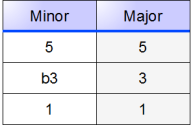
Here is the same chart as it would appear using a C Chord.
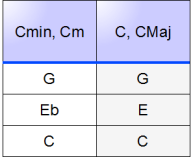
Diminished Chords
Once a minor chord has been established, a Diminished chord is just one step away. Simply take any Minor chord, and lower its fifth one half step. In the same vein of thought, a Diminished chord is only two steps away from a Major chord. Just take a Major Chord, and lower both the third and the fifth one half step, and you're there!
Let's make a D Diminished chord.
- Find the notes of the D minor chord (D, F, and A).
- Lower the fifth one half step, turning the A into a Ab.
- Therefore, the notes D, F, and Ab make up a D Diminished chord.
 D Min to D Dim |
- Find the notes of the D Major chord (D, F#, and A).
- Lower the third one half step, turning the F# into F, and lower the fifth one half step, turning the A into a Ab.
- Using either process (beginning with a Major chord, or beginning with a Minor chord) results in the same notes, D, F, and Ab, and make up a D Diminished chord.
 D Maj to D Dim |
Let us follow the same procedure to make an Eb Diminished chord.
- Find the notes of the Eb minor chord (Eb, Gb, and Bb).
- Lower the fifth one half step, turning the Bb into a Bbb (yes, this is a double flat).
- Therefore, the notes Eb, Gb, and Bbb make up an Eb Diminished chord.
 Eb Min to Eb Dim |
- Find the notes of the Eb Major chord (Eb, G, and Bb).
- Lower the third one half step, turning the G into Gb, and lower the fifth one half step, turning the Bb into a Bbb.
- Using either process (beginning with a Major chord, or beginning with a Minor chord) results in the same notes, Eb, Gb, and Bbb, and make up an Eb Diminished chord.
 Eb Maj to Eb Dim |
Let us now add the Diminished chord construct to our chart. Again, notice how closely related all the chords are, and how simply one can be formed, based on the notes from another.
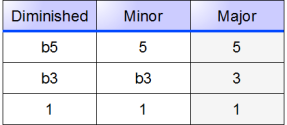
And here is the chart, as applied to the C chord:

Augmented Chords
The Augmented chord is the final of these "simple," three note chords. Like the Minor and Diminished, it is also just a step away from the Major chord. To augment means to increase, so to make an Augmented chord, simply take any Major chord, and raise its fifth one half step.
Let's make a F Augmented chord.
- Find the notes of the F Major chord (F, A, and C).
- Raise the fifth one half step, turning the C into a C#.
- Therefore, the notes F, A, and C# make up a F Augmented chord.
 F Maj to F Aug |
Let us follow the same procedure again to make a B Augmented chord.
- Find the notes of the B Major chord (B, D#, and F#).
- Raise the fifth one half step, turning the F# into Fx (F double-sharp).
- Therefore, the notes B, D, and Fx make up a B Augmented chord.
 B Maj to B Aug |
Here is the final addition to our simple chart. Notice that the Augmented chord is placed to the right the Major chord, reflecting the "raised" character of its construction. Similarly, the Minor and Diminished chords are placed to the left of the Major chord, because of the "falling" nature of their thirds and fifth.

Here is the chart as applied to a C chord:
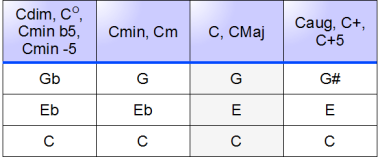
How To Form 7th Chords
7th Chords are perhaps the single most confusing area of music theory for musicians to master. They are not difficult, but their construction is often explained in such a cryptic way that even the simplest concepts are made difficult. This set of articles will attempt to explain 7th chords in a clear, but thorough, way. Make no mistake, 7th chords do take some effort to understand, but are otherwise within the grasp of most pianists.
All 7th chords are formed as a combination of of four notes (i.e., a basic triad, accompanied by a fourth note, the interval of a 7th above the root). To aid our understanding of 7th chords, we will use a chart, much as we did in understanding simple chords. There are six basic types of 7th chords, all of which we will cover: Major, Dominant, Minor, Half-Diminished, Diminished, and Augmented.
In order to find the notes of the 7th chords, we will define them in terms of a Triad and an Interval. The Triad will be either a Major, Minor, Diminished, or Augmented chord, based on the root. The Interval refers to the 7th which we will add to the Triad. It is called a 7th because it is located the interval of a 7th (either Major, Minor, or Diminished) above the root of the chord. We will now see how the triad and the interval work together to form a 7th chord.
Major 7th Chord
I choose to begin with Major 7ths because of their simplicity. They are not the most common form of 7th chord, but could easily come in second. As with simple chords, it is important that we be able to think in the key of the root of the chord. In order to describe how this chord is built, we will refer to the Triad and the 7th interval. For the Major 7th chord, we use a Major/Major construction. Quite simply, this means a Major triad, and a Major 7th interval above the root.
As an example, let's form a G Major 7th chord.
- A Major 7th chord is made up of a Major triad, and a Major 7th interval.
- The name of the chord gives us the root, that is, G.
- We know that a G Major triad is made up of G, B, and D.
- The Major 7th Interval above G is F#.
- Therefore, the notes G, B, D, and F# make up the G Major 7th chord.
 G Maj 7th |
Let us follow the same procedure again to form a Bb Major 7th chord.
- A Major 7th chord is made up of a Major triad, and a Major 7th interval.
- The name of the chord gives us the root, that is, Bb.
- We know that a Bb Major triad is made up of Bb, D, and F.
- The Major 7th Interval above Bb is A.
- Therefore, the notes Bb, D, F, and A make up the Bb Major 7th chord.
 Bb Maj 7th |
We will now begin to create a new chart for the construction of 7th Chords based on this Triad/Interval method.

Here is the chart as applied to a C chord:

Dominant 7th Chords
Dominant 7th chords are by far the most common form of 7th chord. In fact, they are so common that, while other 7th chords are written out by several letter and number combinations (such as EM7, Fo7, Db+7, etc.), the Dominant 7th is indicated by just a "7" after the chord name (A7, Gb7, B7, etc.).
There are several reasons as to why it is called a "Dominant" 7th. The easiest to explain is that, when played, it dominates the music in such a way as to make the music resolve to a chord a fifth lower than the Dominant 7th (G Dominant 7th leads to a C). Much like altering simple chords, the Dominant 7th chord can be formed by altering the Major 7th. Instead of using a Major Triad/Major Interval combination, we will use a Major Triad/Minor Interval combination.
The phrase "Major Triad/Minor Interval" may seem odd to you. Don't worry, you're not alone. You won't hear musicians talking about chords like that. Here, though, the phrase is a shorthand way to say, "A 4-note chord built from a Major Triad with an added note the interval of a Minor 7th above the root." In lieu of such a wordy description, I opted to use the term "Major Triad/Minor Interval" when discussing the construction of this particular chord. Elsewhere, we will simply use it's functional name, "Dominant 7th".
As an example, let's form an Eb Dominant 7th chord.
- A Dominant 7th chord is made up of a Major triad, and a Minor 7th interval.
- The name of the chord gives us the root, that is, Eb.
- We know that an Eb Major triad is made up of Eb, G, and Bb.
- The Minor 7th Interval above Eb is Db.
- Therefore, the notes Eb, G, Bb, and Db make up the Eb Dominant 7th chord.
 Eb Dom 7th |
Let us follow the same procedure again to form a D Dominant 7th chord.
- A Dominant 7th chord is made up of a Major triad, and a Minor 7th interval.
- The name of the chord gives us the root, that is, D.
- We know that a D Major triad is made up of D, F#, and A.
- The Minor 7th Interval above D is C.
- Therefore, the notes D, F#, A, and C make up the D Dominant 7th chord.
 D Dom 7th |
We will now add to our chart the Major/Minor construction of the Dominant 7th Chord. As you can see, the only difference between the Major 7th and the Dominant 7th is the 7th itself (yes, that is a mouthful!). Since both chords are based on the Major triad, the chart attempts to reflect this similarity by sharing the "Major Triad" box. This will be a helpful feature of the chart, once it is filled in with all six forms of the 7th chord!

Here is the chart as applied to a C chord:
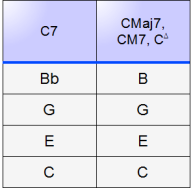
Minor 7th Chords
By now, you should be seeing the advantage to using the Triad/Interval combination to describe 7th chords. We have now seen the Major and Dominant 7th's, so now we will look at the Minor 7th chord. Minor 7th chords are formed using a Minor Triad/Minor Interval combination. (Notice that the Major 7th is Major/Major, and the Minor 7th is Minor/Minor. This will make it easier to remember.)
As an example, let's form a C Minor 7th chord.
- A Minor 7th chord is made up of a Minor triad, and a Minor 7th interval.
- The name of the chord gives us the root, that is, C.
- We know that a C minor triad is made up of C, Eb, and G.
- The Minor 7th Interval above C is Bb.
- Therefore, the notes C, Eb, G, and Bb make up the C Minor 7th chord.
 C Min 7th |
Let us follow the same procedure again to form a F Minor 7th chord.
- A Minor 7th chord is made up of a Minor triad, and a Minor 7th interval.
- The name of the chord gives us the root, that is, F.
- We know that a F Minor triad is made up of F, Ab, and C.
- The Minor 7th Interval above F is Eb.
- Therefore, the notes F, Ab, C, and Bb make up the F Minor 7th chord.
 C Min 7th |
We now expand our chart to include the Minor 7th chord construction. Notice that both the Major 7th and Dominant 7th columns are shaded, being the most common forms of the 7th chord. Again, this shading also helps us to visually see the relationship between the different types of chords.

Here is the chart as applied to a C chord:

Half-Diminished 7th Chord
Yes, the name of this chord is the Half-Diminished 7th chord. Most people do not acknowledge it's existence, and yet is is a very important chord in music theory. Furthermore, it is not difficult to describe using the Triad/Interval method. It's construction, Diminished/Minor, fully indicates which notes make up the chord (as well as give a clue as to why it is called a Half-Diminished chord).
As an example, let's form a D Half-Diminished 7th chord.
- A Half-Diminished 7th chord is made up of a Diminished triad, and a Minor 7th interval.
- The name of the chord gives us the root, that is, D.
- We know that a D Diminished triad is made up of D, F, and Ab.
- The Minor 7th Interval above D is C.
- Therefore, the notes D, F, Ab, and C make up the D Half-Diminished 7th chord.
 D Half-Dim 7th |
Let us follow the same procedure again to form a B Half-Diminished 7th chord.
- A Half-Diminished 7th chord is made up of a Diminished triad, and a Minor 7th interval.
- The name of the chord gives us the root, that is, B.
- We know that a B Diminished triad is made up of B, D, and F.
- The Minor 7th Interval above B is A.
- Therefore, the notes B, D, F, and A make up the B Half-Diminished 7th chord.
 B Half-Dim 7th |
We will now add to our chart the Diminished/Minor construction of the Half-Diminished 7th Chord. Please note that the symbol for the Half-Diminished Chord is a circle with a line through it (i.e., Bb Half-Diminished 7th is Bbø7). You may not have this "slashed circle" on your keyboard, so a common way to write the chord is also "Bbmin7-5". This rather long way of writing the chord name means, "Start with a Bbmin7 chord, and flat the fifth." When hand writing chord symbols, most people prefer the "slashed circle" method, but most printed music and lead sheets will use the longer, "min7-5" description. (This also brings up an interesting observation: the only difference between a Minor 7th chord and a Half-Diminished 7th chord is that the latter has a flatted fifth.)

Here is the chart as applied to a C chord:
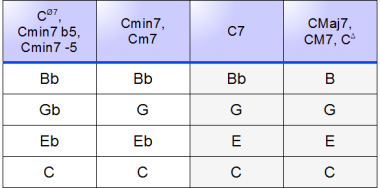
Diminished 7th Chord
The Diminished 7th chord (which is sometimes referred to as the "Fully" Diminished 7th chord in order to differentiate between it and the Half-Diminished 7th chord) is the "lowest" chord arrangement possible for 7ths. Each note is stacked a minor 3rd above the previous note.
The mere mention of this chord scares many people, simply because they do not understand it. It is a very versatile chord, however, with a variety of uses (especially in chord progressions and substitutions). This amazing chord even occurs four times in the hymn The Old Rugged Cross, although most church pianists never realize it. We describe it as having a Diminished/Diminished construction in the Triad/Interval system.
As an example, let's form an E Diminished 7th chord.
- A Diminished 7th chord is made up of a Diminished triad, and a Diminished 7th interval.
- The name of the chord gives us the root, that is, E.
- We know that an E Diminished triad is made up of E, G, and Bb.
- The Diminished 7th Interval above E is Db.
- Therefore, the notes E, G, Bb, and Db make up the E Diminished 7th chord.
 E Dim 7th |
Let us follow the same procedure again to form an Ab Diminished 7th chord.
- A Diminished 7th chord is made up of a Diminished triad, and a Diminished 7th interval.
- The name of the chord gives us the root, that is, Ab.
- We know that an Ab Diminished triad is made up of Ab, Cb, and Eb.
- The Diminished 7th Interval above Ab is Gbb.
- Therefore, the notes Ab, Cb, Eb, and Gbb make up the Ab Diminished 7th chord.
 Ab Dim 7th |
If you didn't notice in the above example, it is quite common (though not always the case) for a Diminished 7th to have one or more double flats. Now we can add the Diminished/Diminished form of the 7th Chord to our chart, but we are not done yet. We still have one more type of 7th chord to cover.

Here is the chart as applied to a C chord:

Augmented 7th Chord
We are to the last type of 7th chord! The Augmented 7th chord is often seen as a hybrid between an Augmented chord, and a Dominant 7th chord, because of its Augmented/Minor construction. The Augmented 7th chord is shamefully overlooked by most pianists, for it has an interesting color and appeal. Later, we will examine some of its uses in chord progressions and substitutions.
As an example, let's form a D Augmented 7th chord.
- An Augmented 7th chord is made up of an Augmented triad, and a Minor 7th interval.
- The name of the chord gives us the root, that is, D.
- We know that a D Augmented triad is made up of D, F#, and A#.
- The Minor 7th Interval above D is C.
- Therefore, the notes D, F#, A#, and C make up the D Augmented 7th chord.
 D Aug 7th |
Let us follow the same procedure again to form a F Augmented 7th chord.
- An Augmented 7th chord is made up of an Augmented triad, and a Minor 7th interval.
- The name of the chord gives us the root, that is, F.
- We know that a F Augmented triad is made up of F, A, and C#.
- The Minor 7th Interval above F is Eb.
- Therefore, the notes F, A, C#, and Eb make up the F Augmented 7th chord.
 F Aug 7th |
In the above examples, notice how some augmented chords will have both sharps and flats in the chord spellings. This is correct spelling for these chords. In the F Augmented 7th example (F, A, C#, and Eb), some would like to write this as F, A, Db, Eb. While the notes would sound the same, the chord would be spelled wrong. ANND ITZ UNOIEENG TOO HAV TWO REED MISPALED WERDZ! Let's see our completed chart:

Here is the chart as applied to a C chord:

(Just About) Every Possible C Chord
| Attachment | Size |
|---|---|
| 15.14 KB |
This is a PDF file (meaning you need Adobe Acrobat Reader in order to view the file) showing almost every C chord in existence. Actually, the list is still incomplete, since there are always more extensions that can be added to basic chords (i.e., C13 can become C13-5+9, etc.).
There are similar lists like this elsewhere on the Internet, but I have found them to be full of duplicates and mistakes. I have tried to arrange the chords in a logical order to help you see the patterns of how chords are formed. I have also listed the general abbreviations found in most modern lead sheets and song books. Let me know if this list is helpful, if you find any mistakes or duplications, or if you can think of a way for me to make it even better!